Customer Logins
Obtain the data you need to make the most informed decisions by accessing our extensive portfolio of information, analytics, and expertise. Sign in to the product or service center of your choice.
Customer Logins
ECONOMICS COMMENTARY
Jan 25, 2023
US January's flash PMI data add to recession signals, but also point to rising cost pressures
The US economy has started 2023 on a disappointingly soft note, with business activity contracting sharply again in January according to the latest business survey data from S&P Global. Although moderating compared to December, the rate at which output is declining is among the steepest seen since the global financial crisis, reflecting falling activity across both manufacturing and services.
Jobs growth has also cooled, with January seeing a far weaker increase in payroll numbers than evident throughout much of last year, reflecting a hesitancy to expand capacity in the face of uncertain trading conditions in the months ahead. Although the survey saw a moderation in the rate of order book losses and an encouraging upturn in business sentiment, the overall level of confidence remains subdued by historical standards. Companies cite concerns over the ongoing impact of high prices and rising interest rates, as well as lingering worries over supply and labor shortages.
The worry is that, not only has the survey indicated a downturn in economic activity at the start of the year, but the rate of input cost inflation has accelerated into the new year, linked in part to upward wage pressures, which could encourage a further aggressive tightening of Fed policy despite rising recession risks.
Below we list five key areas of focus from the latest survey data.
1. US recession risks persist
US composite PMI output index vs. GDP

The headline PMI output index covering both manufacturing and services rose in January, but only improved in the context of December's reading having been the second-lowest since the global financial crisis (if early pandemic lockdown months are excluded). The index registered 46.6, up from 45.0 at the end of 2022. The sub-50 reading means the contraction in activity was solid overall, albeit the slowest since last October.
Other early economic activity indicators, including those compiled by the Philadelphia Fed and the New Yok Fed, have likewise been flashing red warning lights on the health of the economy in January, pointing to a subdued start to the year and, like the PMI, commensurate with falling GDP.
Higher frequency official data, such as industrial production and retail sales, have meanwhile also started to corroborate the PMI survey signals of the economy hitting a soft patch, with both manufacturing output and retail sales falling into decline at the end of last year.
2. US sectors show broad based downturn
Goods producers and service providers recorded similar rates of decline in the flash January PMI survey, pointing to a further broad-based weakening of the economy. Although both sectors reported the rate of output decline to have eased slightly, linked to weaker rates of loss of new orders in both cases, in each sector the downturn remained historically strong.
US services and manufacturing output
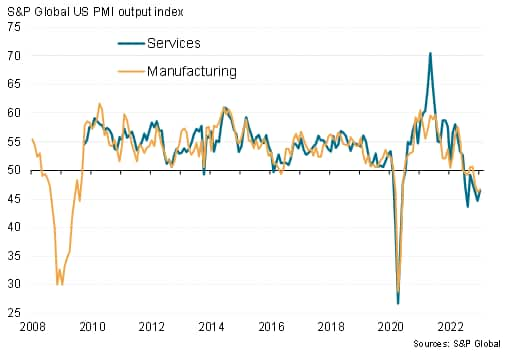
Manufacturing survey comparisons
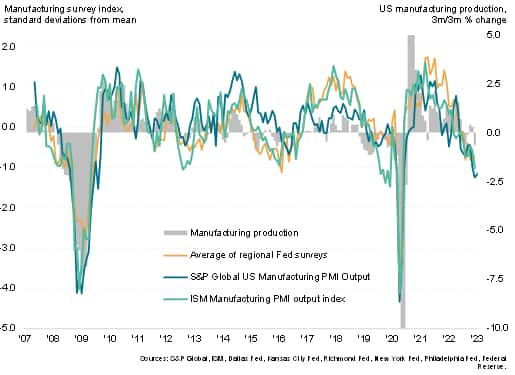
Services survey comparisons
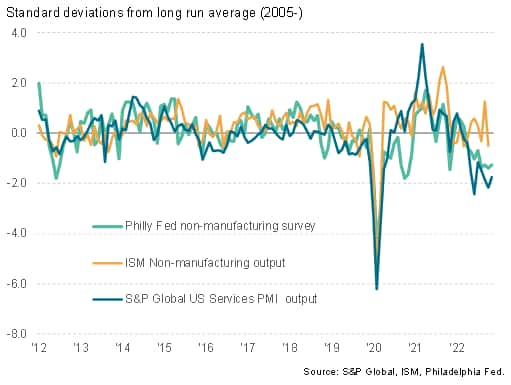
3. US inflation gauges tick higher
Despite demand continuing to fall in January, the survey brought signs of inflation pressures picking up again. Bringing to an end a seven-month sequence of moderating input price rises, January's data indicated a faster increase in cost burdens at private sector firms. Although well below the average rise seen over the prior two years, companies reported persistent upward pressure on costs from hikes in vendor prices and higher wage bills.
The rate of selling price inflation likewise ticked higher in manufacturing during January, and held steady in services. Although efforts to remain competitive and offer concessions to customers dampened output price hikes, companies also reported the need to pass historically elevated costs on to clients where possible.
US PMI input cost and selling price gauges
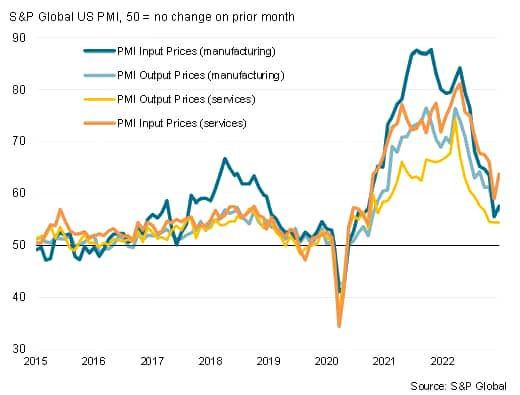
It remains to be seen if January's upturn in the price gauges proves the start of a resurgent upward trend, or whether it represents a higher than normal number of companies setting new list prices at the start of the year. However, even with the latest upturn, the survey gauges are consistent with consumer price inflation cooling further from its current rate of 6.5% in the coming months.
US input costs vs. annual CPI inflation
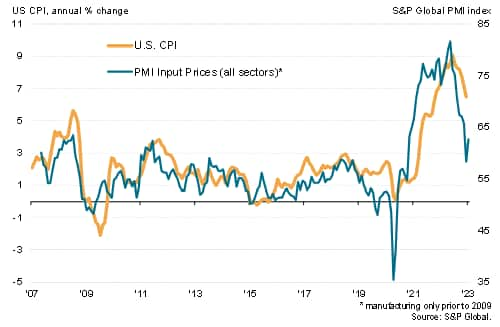
The cooling of inflation has been a function of falling demand (as measured by the sustained decline recorded by the PMI new orders index at 47.9 in January) but also reflects an alleviation of pandemic-related supply chain stress. Average supplier delivery delays rose only marginally in January, and have now been broadly unchanged over the past three months, marking a major change to the widespread supply delays that plagued the US (and global) economy this time last year.
US supplier delivery times vs. monthly CPI
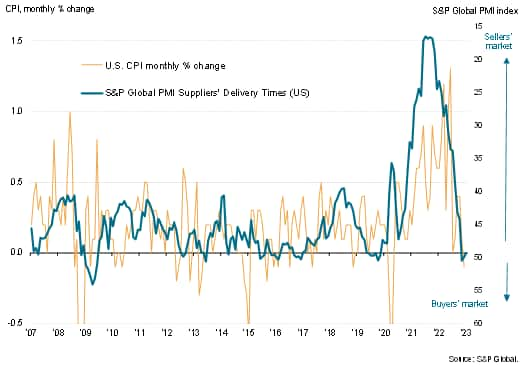
4. US labour market remains tight
However, instead of emanating from supply chains, the survey responses indicate that a key impetus to cost growth is now coming from staff costs via rising wages and salaries. The service sector input cost index (which includes wages) and the employment indices will therefore be important inflation barometers to watch in the months ahead. Importantly, even with the downturn in orders and output seen during the month, employment continued to rise marginally in January as many firms sought to fill long-standing vacancies, left empty due to widespread staffing availability issues. That the PMI survey has shown a marked cooling in jobs growth in recent months is of course noteworthy, and a sign of economic stress, but so is the fact that even the reduced rate of jobs growth is not consistent with any material rise in unemployment.
US unemployment and the PMI employment index
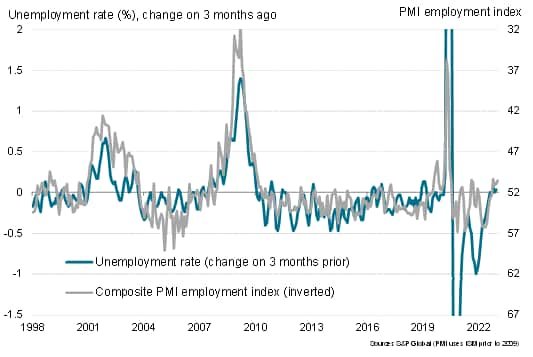
5. Fed policy impact assessment
The 'big picture' from the survey is therefore that the economy continues to face a risk of recession, and yet inflationary pressures are showing signs of remaining stubbornly elevated, thanks in part to the tight labour market. As prior weak survey data have failed to discourage the FOMC from aggressive rate hikes, with policymakers citing a preference to tackle inflation, January's continued fall in output will likewise likely be dismissed. Instead, the rising cost gauges suggest the majority on the FOMC will consider there to be more work to do in taming price pressures.
US PMI output and price data vs. FOMC policy changes
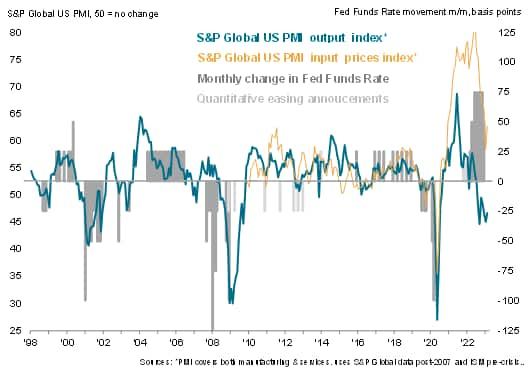
Access the press release here
Chris Williamson, Chief Business Economist, S&P Global Market Intelligence
Tel: +44 207 260 2329
© 2023, S&P Global Inc. All rights reserved. Reproduction in
whole or in part without permission is prohibited.
Purchasing Managers' Index™ (PMI™) data are compiled by IHS Markit for more than 40 economies worldwide. The monthly data are derived from surveys of senior executives at private sector companies, and are available only via subscription. The PMI dataset features a headline number, which indicates the overall health of an economy, and sub-indices, which provide insights into other key economic drivers such as GDP, inflation, exports, capacity utilization, employment and inventories. The PMI data are used by financial and corporate professionals to better understand where economies and markets are headed, and to uncover opportunities.
This article was published by S&P Global Market Intelligence and not by S&P Global Ratings, which is a separately managed division of S&P Global.
{"items" : [
{"name":"share","enabled":true,"desc":"<strong>Share</strong>","mobdesc":"Share","options":[ {"name":"facebook","url":"https://www.facebook.com/sharer.php?u=http%3a%2f%2fstage.www.spglobal.com%2fmarketintelligence%2fen%2fmi%2fresearch-analysis%2fus-januarys-flash-pmi-data-add-to-recession-signals-but-also-point-to-rising-cost-pressures-Jan23.html","enabled":true},{"name":"twitter","url":"https://twitter.com/intent/tweet?url=http%3a%2f%2fstage.www.spglobal.com%2fmarketintelligence%2fen%2fmi%2fresearch-analysis%2fus-januarys-flash-pmi-data-add-to-recession-signals-but-also-point-to-rising-cost-pressures-Jan23.html&text=US+January%27s+flash+PMI+data+add+to+recession+signals%2c+but+also+point+to+rising+cost+pressures+%7c+S%26P+Global+","enabled":true},{"name":"linkedin","url":"https://www.linkedin.com/sharing/share-offsite/?url=http%3a%2f%2fstage.www.spglobal.com%2fmarketintelligence%2fen%2fmi%2fresearch-analysis%2fus-januarys-flash-pmi-data-add-to-recession-signals-but-also-point-to-rising-cost-pressures-Jan23.html","enabled":true},{"name":"email","url":"?subject=US January's flash PMI data add to recession signals, but also point to rising cost pressures | S&P Global &body=http%3a%2f%2fstage.www.spglobal.com%2fmarketintelligence%2fen%2fmi%2fresearch-analysis%2fus-januarys-flash-pmi-data-add-to-recession-signals-but-also-point-to-rising-cost-pressures-Jan23.html","enabled":true},{"name":"whatsapp","url":"https://api.whatsapp.com/send?text=US+January%27s+flash+PMI+data+add+to+recession+signals%2c+but+also+point+to+rising+cost+pressures+%7c+S%26P+Global+ http%3a%2f%2fstage.www.spglobal.com%2fmarketintelligence%2fen%2fmi%2fresearch-analysis%2fus-januarys-flash-pmi-data-add-to-recession-signals-but-also-point-to-rising-cost-pressures-Jan23.html","enabled":true}]}, {"name":"rtt","enabled":true,"mobdesc":"Top"}
]}





